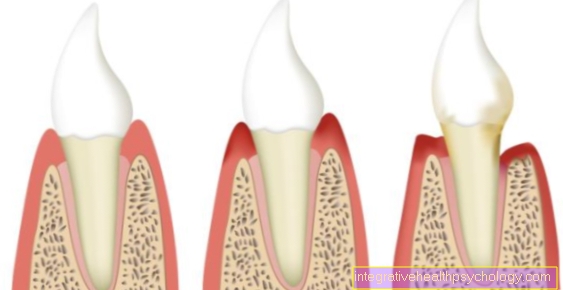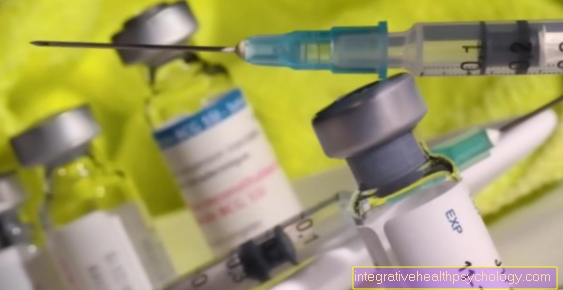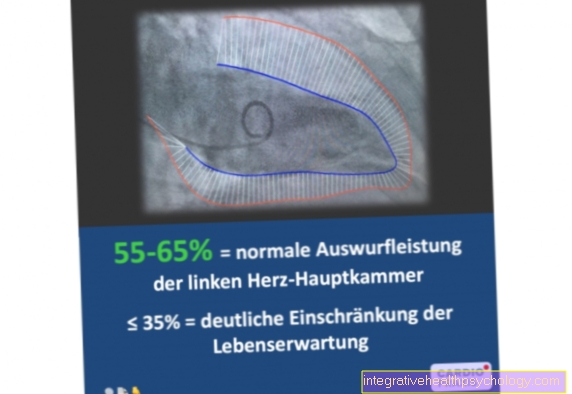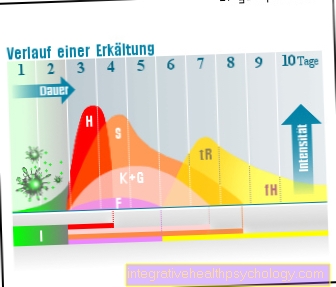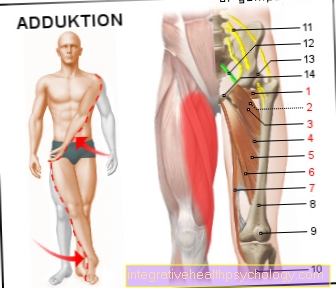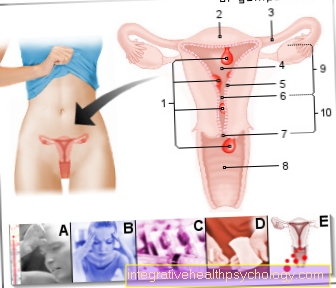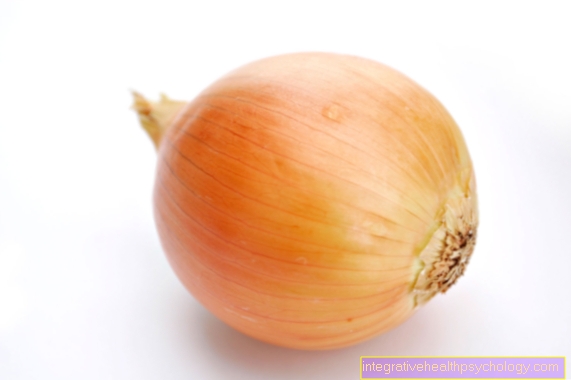Inflammation of the trachea
Synonyms
- Tracheitis
Synonyms in the broader sense:
- Chronic windpipe inflammation, inflammation of the upper respiratory tract
introduction
An inflammation of the windpipe is a disease of the upper respiratory tract that can be infectious, allergic or chemically irritative. Only in very few cases can the inflammation of the windpipe be observed without the presence of further symptoms. Inflammatory processes usually occur simultaneously in the nose (rhinitis), larynx (laryngitis) and / or bronchi (bronchitis). Although inflammation of the windpipe can develop during the warm months, most cases occur during winter. In addition to bacterial or viral pathogens, chemical substances can also irritate the mucous membrane of the trachea and cause inflammation of the trachea.

The most well-known chemical substances in this context include cigarette smoke, sulfur dioxide, ozone and ammonia. The inflammation of the windpipe is medically divided into two different forms (acute and chronic inflammation of the trachea). These two forms differ mainly in terms of the frequency of their occurrence and the duration of healing.
In addition, different triggers can be named for both forms. Patients who suffer from inflammation of the trachea usually show pronounced symptoms. If the symptoms persist or are particularly pronounced, a doctor should be consulted promptly and an extensive diagnosis should be carried out.
The prognosis for inflammation of the trachea, the better the earlier an appropriate treatment is started. Patients who frequently develop inflammation of the windpipe should also think about eliminating possible risk factors (for example by giving up smoking).
Symptoms
Inflammation can only be observed in the rarest of cases without the presence of further symptoms. As a rule, the affected patients suffer from a severe runny nose and severe cough. Depending on the form of the disease, this cough can be both dry and productive (with expectoration) be.
The chronic inflammation of the windpipe is usually accompanied by a dry, tickly cough. In addition, inflammatory processes can develop within the paranasal sinuses at the same time. These often lead to increased headaches, feelings of pressure and discomfort in the upper front molars. These complaints increase significantly in intensity, especially when the head is bent over.
Other symptoms of inflammation of the windpipe are:
- hoarseness
- to cough
- burning sensation under the breastbone
- Fever and chills
- Muscle and joint pain
- Exhaustion
Due to the small diameter of the upper airways, inflammation of the larynx or windpipe can be dangerous, especially in young children.
Typical symptoms of inflammation of the windpipe in the child are:
- shortness of breath
- Retraction on the chest
- pronounced abdominal breathing
- increased breathing rate
- Restlessness / panic
- loud noises while breathing out (expiratory stridor)
Inflammation of the trachea and shortness of breath
The inflammation of the windpipe makes the mucous membrane very irritated and sensitive to pain. This can cause pain when breathing. Affected people tend to breathe less and there is difficulty breathing. An inflammation of the mucous membranes also always leads to swelling. Depending on how severe the swelling is, the diameter of the esophagus narrows and less air gets into the lungs. This can quickly lead to shortness of breath, in the worst case to respiratory failure. A doctor must be consulted as soon as possible and drug therapy with decongestants must be initiated.
therapy
If an inflammation of the windpipe is suspected, a doctor should be consulted as soon as possible. This is especially true when those affected are small children.
An inflammation of the windpipe must be treated as quickly and specifically as possible. The most important treatment measure for patients suffering from chronic inflammation of the windpipe is to reduce the relevant risk factors. In this context, smoking cessation and avoiding inhalation of gases that irritate the mucous membranes play a role.
In addition, the irritating cough associated with the inflammatory processes can be relieved by natural cough suppressants and / or teas. If there is inflammation of the windpipe, chamomile, linden blossom and sage tea are particularly suitable.
In addition, the typical symptoms of windpipe inflammation can be alleviated by sucking candy containing anti-inflammatory herbs and / or eucalyptus. These moisturize the oral cavity and help to keep the inflamed airways free. In serious cases of illness or if there is an inflammation of the trachea in childhood, it must always be remembered that the inflammatory processes can spread to the lungs (pneumonia). For this reason, the initiation of antibiotic therapy can be useful. However, this assumes that the affected patient has a bacterial inflammation of the trachea. Blood tests may confirm this suspicion. In addition, various drugs can be taken to stop the permanent irritable cough.
Which doctor treats trachitis?
Since an inflammation of the trachea rarely occurs alone, but mostly as part of a general infection of the airways, the treatment is carried out by a general practitioner or internist. Depending on the severity of the inflammation, treatment can be carried out on an outpatient or inpatient basis. In the case of complicated processes, a Pulmonologist (Pulmonologist) should be consulted.
When do you need cortisone?
Cortisone is usually only required for chronic, protracted or complicated processes in order to suppress the body's own defense system and thereby contain the inflammation. Cortisone has a number of side effects and should only be administered if strictly indicated. Cortisone is administered according to a fixed schedule and must always be tapered off.
Read more on the topic: Cortisone
homeopathy
Depending on the cause of the inflammation of the windpipe, homeopathic remedies can be taken, but their effect is controversial. However, an antibiotic should be given for bacterial infections. A more commonly prescribed remedy is Sulfur, it is based on sulfur and is used for chronic and acute inflammation of the skin, respiratory tract and digestive tract. Other substances are spongia or, in the case of advanced inflammation, ipecacuanha. All substances are administered in D6 dilution.
Duration of an inflammation of the trachea
The duration of an inflammation of the windpipe depends on the cause. If a viral infection is the trigger, the inflammation often heals on its own after a few days to two weeks. If a bacterial (super) infection also forms, recovery can take up to 2-3 weeks. Small children, old people and people with previous illnesses are at risk, and more severe courses can arise here. The therapy can last for several weeks to months. If, in rare cases, a chemical substance that is inhaled is responsible for the inflammation, the inflammation should usually occur after exposure (suspension) disappear again.
Prevention (prevention)
Due to the numerous causes, the prevention the inflammation of the windpipe as difficult prove.
Most of the chronic forms are caused by inhalation of irritating substances. As in this context especially Cigarette smoke Playing a crucial role can be early Smoking cessation help prevent inflammation of the windpipe. In addition, work-related inhalation of various substances that irritate the mucous membranes can occur. The prevention of inflammatory processes in the area of the windpipe can be achieved by wearing a Respirator guaranteed.
In addition, it can be observed that especially people who have a poor immune system feature (immunodeficiency) often suffer from inflammation of the windpipe. For this reason, the Strengthening of the body's own Immune system represents an important step in the prevention of inflammatory processes in the upper respiratory tract. A balanced diet rich in vitamins and regular Movement units in the fresh air are in most cases enough to sustainably strengthen the immune system.
In addition, that too Humidifying the dry room air help both to relieve the symptoms of an existing inflammation of the windpipe and to reduce the risk of such a disease occurring. Dry room air irritates the mucous membranes and dries them out. As a result, the causative pathogens can better penetrate the tissue of the windpipe and multiply there unhindered. The release of their metabolic end products ultimately drives various inflammatory reactions and inflammation of the windpipe can occur.
Is trachitis contagious?
Depending on the cause of the airway inflammation, it can also be contagious. Inflammation of the trachea is often caused by viruses or bacteria. These can be transmitted through the air through droplet infection when coughing or sneezing and can also cause inflammation of the windpipe or other parts of the respiratory tract in other people. Immune-weakened people such as small children, old people or patients with previous illnesses are particularly at risk. If the trachitis was caused by an existing allergy or exposure to chemical pollutants, the inflammation is not contagious.
causes
The causes of inflammation of the windpipe can be different. The most common form of this disease is acute tracheitis.
In most cases, this is caused by bacterial or viral pathogens.
In most cases, the affected patients first develop a simple infection of the upper respiratory tract (bronchitis) with a cough and runny nose. After the initial infection of the paranasal sinus-throat area, the pathogens reach the larynx and trigger inflammatory processes there.
In the course of the disease, the causative pathogens spread further and settle one level lower in the area of the windpipe.
In direct comparison, most inflammatory processes in the larynx and windpipe are caused by viruses. Bacterial infections are much less common in this area. In patients who suffer from a restricted immune situation (for example diabetes mellitus or HIV), the inflammation of the trachea can also be triggered by fungi.
Chronic forms of inflammation of the windpipe are in most cases related to chemical irritants. This form of inflammation of the windpipe can be observed especially in long-term smokers. In addition, chronic tracheitis can be caused by narrowing of the windpipe (for example by a tumor) or mechanical obstacles (foreign body) caused.
Another common cause of the development of inflammatory processes in the area of the trachea is the so-called "Tracheomalacia". With this disease there is a pathological slackening of the tracheal muscles, which leads to a long-lasting, irritable cough.
Classification
The inflammation of the windpipe can be divided into different forms based on certain criteria. Such a subdivision of this disease is particularly useful with regard to the choice of the most suitable treatment.
Classification according to course form:
- Acute inflammation of the windpipe
- Chronic inflammation of the windpipe
Classification according to cause:
- Infectious inflammation of the windpipe
- Allergic inflammation of the windpipe
- Chemically irritative inflammation of the windpipe (e.g. from irritant gases)
- Mechanically irritative inflammation of the windpipe (e.g. after intubation)
Classification according to pathology:
- Membranous inflammation of the windpipe
- Pseudomembranous inflammation of the windpipe
- Haemorrhagic inflammation of the windpipe
- Necrotizing inflammation of the windpipe
diagnosis
The presence of an inflammation of the windpipe is diagnosed in most cases based on the typical symptoms.
During an extensive doctor-patient conversation (anamnese) the affected patient should therefore describe in as much detail as possible which symptoms are present and under which conditions they are observed. Above all, the hoarse voice and the permanent dry cough can be a first
Provide an indication of the underlying problem.
Following this doctor-patient conversation, the treating doctor usually carries out a physical examination. During this examination, the lungs are listened to for abnormalities and tapped. If there is inflammation of the windpipe, noticeable flow noises can be heard, especially during exhalation.
In children, these can usually be detected without a stethoscope. In addition, taking x-rays can help rule out pneumonia. If the findings are unclear, a pulmonary function test can also be ordered. However, since the inflammation of the windpipe can in most cases be diagnosed simply by looking at the clinic, this is rarely necessary.
Differential diagnoses (diseases with similar symptoms)
For more information on conditions with similar symptoms, see:
- Heartburn / reflux
- lung infection



